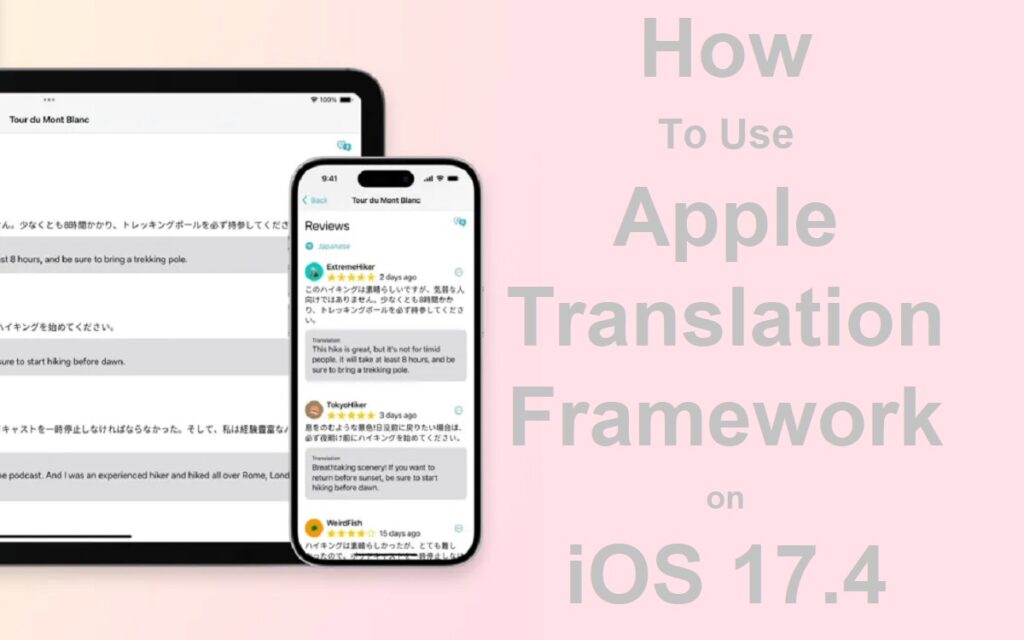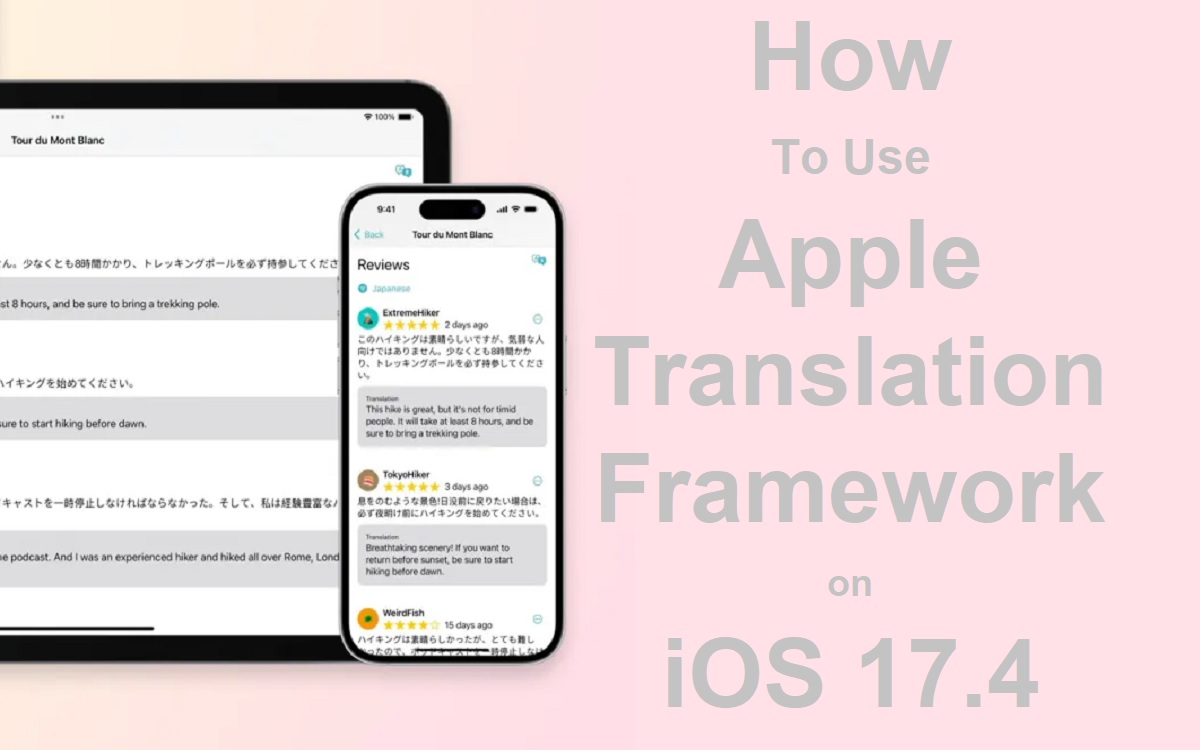With the release of iOS 17.4, Apple has taken a significant step forward in empowering developers to create more inclusive and globally accessible applications. The introduction of the Apple Translation Framework on iOS 17.4 marks a new era in mobile app development, offering powerful on-device translation capabilities that were previously the domain of specialized translation apps or third-party services.
Recent Released: What’s New in iOS 18 Calculator App [Tips and Tricks]
The Apple Translation Framework, its implementation, benefits, limitations, and potential applications. Whether you’re a seasoned iOS developer or just starting your journey in app creation, understanding this framework will open up new possibilities for enhancing user experiences and breaking down language barriers.
What is the Apple Translation Framework?
The Apple Translation Framework is a set of tools and APIs that allow developers to integrate translation capabilities directly into their iOS applications. Introduced with iOS 17.4, this framework leverages the same machine learning models used in Apple’s native Translate app, bringing professional-grade translation services to third-party applications.

Key Features of the Translation Framework
- On-device processing: Translations are performed locally, ensuring privacy and enabling offline functionality.
- SwiftUI integration: The framework is designed to work seamlessly with SwiftUI, Apple’s modern UI toolkit.
- Flexible API: Developers can choose between simple presentation methods or more complex, customizable translation tasks.
- Support for multiple languages: While not as extensive as some third-party services, the framework supports a growing list of languages.
- Real-time translation capabilities: Suitable for applications requiring immediate translation of user input or conversations.
Implementing the Translation Framework in Your iOS App
Setting Up Your Development Environment
Before diving into code, ensure your development environment meets the following requirements:
- Xcode 15 or later
- iOS 17.4 or later as the deployment target
- SwiftUI framework (recommended, but UIKit integration is possible)
Basic Implementation with SwiftUI
Here’s a simple example of how to implement translation in a SwiftUI view:
swift
Copy
import SwiftUI
import Translation
struct ContentView: View {
@State private var showsTranslation = false
let textToTranslate = “Hello, world!”
var body: some View {
VStack { Text(textToTranslate)
.contextMenu {
Button(“Translate”) { showsTranslation = true } }
.translationPresentation(showsTranslation ? textToTranslate : nil) } }}
This code creates a simple view with a text string that can be translated when the user selects “Translate” from a context menu.
Advanced Implementation for Batch Translations
For more complex scenarios, such as translating multiple strings simultaneously, you can use the TranslationSession class:
swift
Copy
import SwiftUI
import Translation
struct BatchTranslationView: View {
@State private var translations: [String] = []
let textsToTranslate = [“Hello”, “How are you?”, “Goodbye”]
var body: some View {
List(translations, id: \.self) { translation in
Text(translation)
}
.onAppear {
translateTexts() }
func translateTexts() {
let session = TranslationSession()
session.translate(textsToTranslate) { result in
switch result {
case .success(let translatedTexts):
self.translations = translatedTexts
case .failure(let error):
print(“Translation error: \(error)”) }
This example demonstrates how to translate an array of strings and update the UI with the results.
Benefits of Using the Apple Translation Framework
1. Enhanced User Experience
By integrating translation capabilities directly into your app, you provide a seamless experience for users who encounter content in unfamiliar languages. This can significantly improve engagement and accessibility, especially for apps with a global user base.
2. Privacy and Security
With on-device translation, user data never leaves the device. This addresses privacy concerns and complies with strict data protection regulations, making it an attractive option for apps dealing with sensitive information.
3. Offline Functionality
The ability to perform translations without an internet connection is a game-changer for travel apps, language learning tools, or any application used in areas with limited connectivity.
4. Resource Efficiency
The translation models are shared across apps, optimizing storage usage on the device. This means that once a user has downloaded language models for the Apple Translate app, your app can utilize these without requiring additional downloads.
5. Native Integration
As part of the iOS ecosystem, the Translation Framework integrates smoothly with other Apple technologies and design paradigms, ensuring a consistent user experience across the platform.
Limitations and Considerations
While the Apple Translation Framework offers numerous advantages, it’s important to be aware of its limitations:
- Language support: The framework currently supports fewer languages compared to some third-party solutions.
- iOS version requirement: Only available on iOS 17.4 and later, which may limit the potential user base.
- SwiftUI focus: While it’s possible to use the framework with UIKit, it’s primarily designed for SwiftUI, which may require additional work for apps built with older UI frameworks.
- Customization constraints: The default translation UI may not suit all app designs, and customization options are somewhat limited.
Real-World Applications
The versatility of the Apple Translation Framework opens up possibilities across various app categories:
- Social Media: Enable users to understand posts and comments in different languages.
- E-commerce: Translate product descriptions and reviews for international customers.
- Travel: Provide real-time translation for conversations, signage, and menus.
- Education: Support language learning apps with instant translation features.
- Customer Service: Facilitate communication between support teams and customers speaking different languages.
Comparison Table: Apple Translation Framework vs. Third-Party Solutions
| Feature | Apple Translation Framework | Typical Third-Party Solution |
| Privacy | On-device processing | Often cloud-based |
| Offline Use | Available | Usually requires internet |
| Language Support | Limited (around 18 languages) | Often more extensive |
| Integration | Native iOS integration | Requires SDK/API integration |
| Cost | Free with iOS | Often subscription-based |
| Customization | Limited | Usually more flexible |
| Update Frequency | Tied to iOS updates | Independent updates |
| Performance | Optimized for iOS devices | Varies |
Future Prospects
As Apple continues to develop and refine the Translation Framework, we can expect to see:
- Expanded language support
- More customization options for developers
- Enhanced accuracy through improved machine learning models
- Deeper integration with other iOS features and frameworks
The upcoming iOS 18 update is rumored to bring improvements such as better in-line translation presentation and bilingual keyboard support, further enhancing the framework’s capabilities.
Finally
The Apple Translation Framework represents a significant step forward in making iOS apps more accessible and user-friendly on a global scale. By providing powerful, on-device translation capabilities, Apple has opened up new possibilities for developers to create truly international applications.
While the framework does have its limitations, its benefits in terms of privacy, offline functionality, and seamless integration with iOS make it an attractive option for many developers. As the framework evolves and expands its capabilities, we can expect to see more innovative uses of translation technology in iOS apps.
For developers looking to reach a global audience or enhance the accessibility of their applications, the Apple Translation Framework offers a compelling solution. By understanding its strengths and limitations, you can make informed decisions about how best to implement translation features in your iOS apps, ultimately creating more inclusive and user-friendly experiences for people around the world.
As we move towards an increasingly connected global community, tools like the Apple Translation Framework will play a crucial role in breaking down language barriers and fostering international understanding. The future of app development is multilingual, and with Apple’s Translation Framework, that future is now within reach for iOS developers everywhere.






